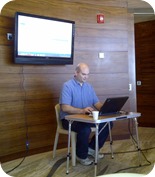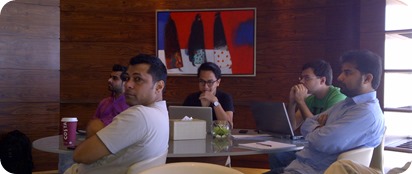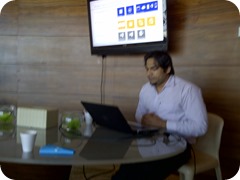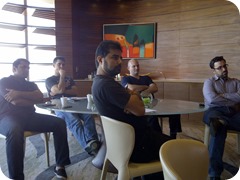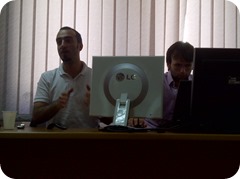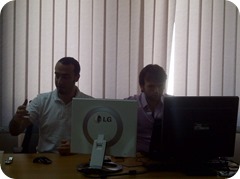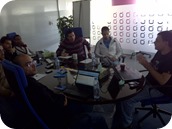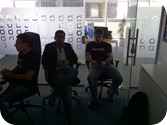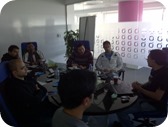Given the top-business-driver is data not compute or network. I would like to use these pages to do my research on the open nuggets of knowledge. I will add/update this post when new info comes in. I think I will create sub-posts on topics that are related such as Zero Trust, Server Less, Code less / low code, cloud-native, SaaS Infra or IaaS, Digital Twin, and AI Transformation driven. I have a bit of time on my hands now as I am in between jobs, Hence building up and sharing the knowledge seems like a good path into a more knowledgeable future.
Why should you read this thread?
First of all, because the topic is hyped as of late. You can feedback in the comments below to address your interests. Second, I noticed that no matter if you are in eco-friendly solar power, remote or hybrid working, do continuous deployment, or work with full cloud enablement, to name a few, you all need near real-time data. You need to decide based on the facts the data provides. In short, you are into data-driven decision-making.
Bullets I will expand on
I do not know how these will fit in exactly just wanted to put down the thoughts I had on the below topics…
- Industry 4.0
- IoT
- Data storage
- Log data and event trace data
- Massive scale data
- Anomaly detection
- Predictable maintenance
Industry 4.0 (IR4)
The defining factor of Industry 4.0 (IR4) is automation. This automation is purely data-driven. It covers the entire supply chain process:
- Design
- Procurement
- Prototyping
- Supply
- Production
- Delivery
- Distribution
- Tracking
- Service
- Support
Even though the process has in its name Industry also Smart cities and smart governments adopt IR4 practices. Digital Twins are an important part as there is a need to have a digital representation. Digitalization is a concept of digitalization that is industry 3.0 (IR3), it needs to be in place before IR4 can occur. For IR4 it is required that all business processes produce data and this data can be exchanged between the processes. From this the processes are observable. In IR3 the driver was to get insights and make decisions from reports. In IR4, the data from previous steps will be consumed by the next. This allows businesses to create a complete automated supply chain process. The automation depends on data being stored in the right place and being able to consume in the right format. ERP systems as of now do not like to have this bulk data in their system, it is really expensive to store in the cloud offerings of SAP, Microsoft, and Oracle. On top of that storing data in these systems from operational technology (OT) is terribly slow. The massive amounts of data need to go elsewhere for processing, mostly cloud-based solutions [1,2,3,4]. Data in the cloud can then be analyzed later, IR4 would actually take the data in real-time and process it to take immediate decisions.
Starting with the digital design process where narrow AI can now augment the design[5,6] within specified requirements. This is the unique part where value is added. Augmented Reality (AR) can bring added value[7]. The creative process under Prototyping will be on a close loop as this will iterate between the two. It is essential to create metrics for quality and target KPIs that have to be attained with the design to validate.
Procurement will be much more strategic and based on automation and business parameters in algorithm-based purchasing[8,9]. AI can work for quality validation of the supply. AI can also monitor market situations to make ad-hoc decisions usually restricted to human input. A significant part of procurement can be augmented with Robotic Process Automation (RPA) where specific business rules are applied to the typical Enterprise Resource Planning (ERP) system. Procurement sets up the supply of materials. When designing and prototyping in a tight loop the procurement is doing smaller batches and researching what can be delivered on the scale, impacting the KPIs that the design can have and the prototype can adhere to.
If prototyping is part of the supply chain within the company, so the purchased materials are augmented, there usually is a process of iterating from design, procurement, and prototyping. The prototype must meet the KPIs given in the design so tests are created. The prototype, therefore, is measured, tested, and analyzed. Artificial Intelligence (AI) and Machine Learning (ML) can help in this process by creating alternatives that might not come up in brainstorming sessions, and also to track what worked and what did not. AR, Virtual Reality (VR) can help create the right product that makes a successful product.
Supply builds business requirements based on exact metrics from the production and sales in a company. Supply is also a consumer of data from suppliers such as metrics of materials delivered and documents such as certifications of the supply. The certification is going to be an increasing factor in processing and guaranteeing the materials are sourced sustainably, without slave/child labor, and do not adversely affect the green nature of the business as a whole. The data of raw materials need to be kept and needs to be carried forward into the delivered/produced product. Trackability is of utmost importance and proof of correctness is becoming important fast too. In reality, this is all in the context of IR3, be it that in IR4 this now can be done with automatic validation, AR and ML can add value by quality measures of the materials and determining the use of these materials in the correct product.
Production requires an exact measurement of the product being created. Knowing exactly which item was consumed at what time by what machine or person and documenting every step of the process that occurred. This is a typical data lake territory from IR3. Steering based on these will happen in real-time as per IR4. Automation will help, ML will help by taking decisions immediately allowing for proper flow of production or value add process. The ability to capture the data work with it in real-time and post analyze and report on it for business quality and assurance or audit purposes will set a business apart and make it unique. A business able to keep this data long enough and condense the business data into an easy format and can trace any work done on a product can continuously improve by seeking out causes for failures, inefficiencies, reduced quality, or too high quality if something needs to have specific lifespan and durability.
Delivery is where all data comes together and needs to be linked to the product and also to the unit of delivery. In IR3 batches were made to combine all data for a set of products as a delivery unit. In IR4 the delivery of the data can precede the delivery of physical products, so the purchaser of the product can anticipate the quality and durability. The delivery of these can help in Just in Time (JIT) relations for the supply chain. Businesses tend to have QR codes, reference batches, and Excel sheets that contain aggregated data. This will no longer be enough there will be an exchange of data lakes, and a company collecting shared central storage of this business data will be the marketplace owner of all production data in a specific supply chain. All producers will supply augmented data, pull the right data for their production from producers in earlier stages of the supply chain and consumers will be able to digest the data.
Distribution is the logistics where products get collected and sent to the next step in the supply chain. The information is contained in tracking and tracing of the shipping of product, this gets augmented into the collection of data for the product. A logistics company produces a fair bit of information. This can be augmented a lot more especially with products that need to be transported within specific pressure, temperature, velocity, acceleration, etc. logistics companies can add a tracker to each container or box that sends data in real-time or collects for later analysis. Only true real-time solutions are allowed in IR4 so these can take automated action and corrective measures needed. The information flows into the product life cycle store.
Tracking of products in the supply chain is crucial to understand the placement, with distribution it is even more so as this is the handover from one supplier in the chain to the next. The next one considers the supplied goods raw materials or half-products to be enhanced. Tracking allows for JIT delivery and interdependence on the chain so end-products become plannable. Each step in the process allows for tracking and showcases the augmentation of a product on its way from raw material to ready-made. Each component might be a part of the assembly of another product tracking of each component is crucial in IR4.
Service, This is a part that can be helped well with all the data available[a,b]. When data is made available in a shared central ledger that can be trusted and is sufficiently durable the entire chain in IR4 can rely on this. Blockchain only certifies a moment in time state is validated against a computational intensive proof. I see much more value in producers, and maintainers of the product having a ledger that links to the original data. The only requirement is then a hash of the original data so that the maintainer can validate the data was not touched. The maintainer or producer has a certificate on their website and the trust in that maintainer or producer validate the storage of the data. No need for a complicated blockchain.
Support, Augmented reality can help a lot here, having AR-supported manuals[c,d]. This helps with the support of the correct use of the product. In IR4 the data produced in the previous steps can be consumed and overlaid on the product. This can be used to prove the product is sustainable, of the correct quality, where the materials come from, who worked on it, etc…
Some consulting visions of IR4: SAP, IBM, Microsoft, Hitachi, Deloitte, PWC, Accenture, CGI, McKinsey, Gartner
My vision: Need for industry-standard storage of material data. This storage must have write-once behavior. When stored the certificate on the portal where data is submitted and retrieved guarantees the source. Any provider should authenticate the data by linking to the (batch of) products. That way there is a ledger outside of the data that validates the data by the owner. The claim can be added to the stored data, that way only once the product can be claimed as produced, and after that, it is consumed as material in other products. The certificate keeps the ledger authentic, the write-once nature of data storage keeps this authentic. Traceability can be used for auditing. Any value-added service can be built on top of this data. The use of data is paid for, and the production of data is paid for also that way it keeps the cost structure honed and clean. Businesses in IR4 will then provide services based on the data only. Leveraging any product into a digital twin that can have a complete extra dimension of value added.

